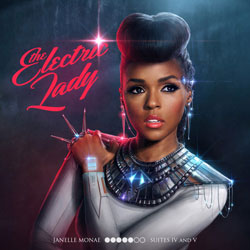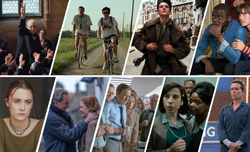R&B isn’t an easy genre to stand out in these days, but for a singer as hard working and charismatic as Janelle Monáe, it’s kind of impossible not to. With a powerful voice, wild imagination, and restless creative spirit, Monáe has made some very exciting and inventive pop music since bursting onto the scene, with her debut album, 2010’s “The ArchAndroid,” being quite an artistic achievement.
Despite her talent, however, her latest record, “The Electric Lady,” shows that even she is still susceptible to one of the biggest curses in the music world: the sophomore slump.
Can you blame her, though? You try following up an album like “The ArchAndroid” – a dense, kinetic, sci-fi-themed odyssey that blended R&B with more genres and styles than I can count on one hand while never losing sight of its infectious pop sensibilities. The fact that something so overly ambitious worked the first time is a miracle in itself. What do you possibly do to follow such a monster?
Monáe was certainly up for the challenge as “The Electric Lady” is still a very ambitious record that clearly comes from the same warped mind as before. But while “The Electric Lady” is still a unique record by modern R&B standards, I can’t help but feel that something is missing this time around.
At a first glance, it might not seem like “The Electric Lady” would be very different from its predecessor. Both records are divided into two “suites” continuing the “Metropolis” storyline of “The ArchAndroid” (as well as her debut EP, “Metropolis: The Chase Suite”). The records average at just under 20 tracks, and Monáe uses a lot of the same session musicians and genre crossovers from the last album.
But while not much has changed structurally, it’s really the soul of the record where things have changed. Many of the orchestral elements and genre shifts still abound, but much of “The ArchAndroid’s” eccentricities (the oddball segue tracks; the dense, slow burning psych-folk attempts; the interlocking pop jams that bleed right into one another) feel highly tempered down for a more streamlined, pop-oriented sound.
This doesn’t have to be a downside for “The Electric Lady.” At her core, Janelle Monáe is a pop superstar through and through. Though her weirdness is a key factor in her music, she’s still responsible for some undeniably great pop songs, like the fiery sparkplug “Cold War” and the ultra-funky, “Big Boi” featuring Tightrope.
But through “The Electric Lady’s massive scope, the high’s that these tracks reached are rarely duplicated. Early tracks “Give Em What They Love” and single “Q.U.E.E.N.,” for instance, bring a very middling start to the album, trading in space-aged bombast for cool, mid-range funk that spark but never launch (though Monáe’s rapped verse near the end of “Q.U.E.E.N.,” backed by swooning strings, offers a bright moment of inspiration). Even big name features like Prince and Erykah Badu (respectively) do little to save these tracks.
The album as a whole has a much greater focus on keeping things cool and tempered in general, though typically with rather droll results. The album is plagued with a number of soft cuts, like “It’s Code” and “Victorious,” that come with some fine sonic touches, but do little to distance themselves from your average contemporary R&B single.
There are moments, however, where these tracks do in fact work. “Slow Jam Primetime,” which acts as a duet with R&B up-and-comer Miguel, is as slick, buttery, and truly soulful as it gets, while Can’t Live Without Your Love, comes off as a classic Destiny’s Child cut, but with twice the emotion and elegance. While these tracks are indeed standouts, I can’t help but feel disappointed by how familiar they all sound, which Monáe has typically been best at avoiding.
There’s still bombast to be found throughout “The Electric Lady,” and when these moments burst, they let out quite a bang. “We Were Like Rock and Roll” charges through with latin00-flavored rhythms and spicy guitar leads, and “Dance Apocalyptic,” the album’s lead single, is Monáe at her most scene-stealing and fun. The track is incredibly infectious to boot. Sure, nothing quite matches “Cold War,” but there’s definitely plenty of energy here to be seized.
The album continues Monáe’s Metropolis suite, a completely wacked out sci-fi adventure complete with droids, clones, time travel, and many other sci-fi tropes that get a bit confusing. Like The ArchAndroid, however, these themes aren’t overbearing in the album’s music or lyrics, and do not require a deep understanding of the plot to enjoy.
Unlike “The ArchAndroid,” however, “The Electric Lady” does a better job of tying the theme together with a number of radio show-themed skits, which highlight many of the story-arcs characters, locations, and even cultural trademarks. Though there’s only three, these skits do a good job of showing the detail that Monáe has put into her dystopian sci-fi world, giving the album a bit more character because of it.
Really though, one of the main things that keeps “The Electric Lady” afloat is Monáe’s commanding voice. A pristine blend of retro and modern R&B, Monáe’s voice hasn’t lost a bit of edge since “The ArchAndroid” – one minute she’s Beyoncé, the next she’s James Brown, then she’s Jackson 5-era Michael Jackson. How she does it, I’ll never know, but even the album’s weakest moments can barely dim her vocals.
All in all, “The Electric Lady” is far from a bad record. It’s expertly produced and wonderfully sung. Perhaps it was necessary for Monáe to tone down her ambitions a bit this time around (honestly, could she really have gone any bigger?). But while “The Electric Lady” is certainly pleasing and even enjoyable in its best moments, unfortunately it’s far from thrilling.
IMAGE TAKEN from thatgrapejuice.net



